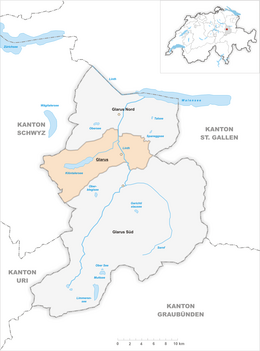Glarus, Switzerland
| Glarus | ||
|---|---|---|
 |
||
|
||
| Coordinates: 47°02′N 9°04′E / 47.033°N 9.067°ECoordinates: 47°02′N 9°04′E / 47.033°N 9.067°E | ||
| Country | Switzerland | |
| Canton | Glarus | |
| District | n.a. | |
| Area | ||
| • Total | 103.7 km2 (40.0 sq mi) | |
| Elevation (Stadtkirche Glarus) | 472 m (1,549 ft) | |
| Population (Dec 2015) | ||
| • Total | 12,570 | |
| • Density | 120/km2 (310/sq mi) | |
| Demonym(s) | German: Glarner(in) | |
| Postal code | 8750, 8754, 8755 | |
| SFOS number | 1632 | |
| Localities | Glarus, Netstal, Ennetbühls, Ennenda, Riedern, Hinter-Klöntal, Richisau, Klöntal | |
| Surrounded by | Glarus Nord, Glarus Süd, Muotathal (SZ), Innerthal (SZ) | |
| Twin towns | Wiesbaden-Biebrich (Germany) | |
| Website |
www SFSO statistics |
|
Glarus (German: [ˈɡlaːrʊs]; Alemannic German: Glaris; French: Glaris; Italian: Glarona; Romansh: Glaruna) is the capital of the canton of Glarus in Switzerland. Since 1 January 2011, the municipality Glarus incorporates the former municipalities of Ennenda, Netstal and Riedern.
Glarus lies on the river Linth between the foot of the Glärnisch (part of the Schwyzer Alps) to the west and the Schilt (Glarus Alps)to the east. Very few buildings built before the fire of 1861 remain. Wood, textile, and plastics, as well as printing, are the dominant industries. The symbol of the city is the neo-romanesque city church.
The official language of Glarus is (the Swiss variety of Standard) German, but the main spoken language is the local Alemannic Swiss German dialect.
Glarus is first mentioned in the early 9th Century in Latin as Clarona. In 1178 it was first mentioned in German as Glarus.
On 10 February 878, the Emperor Charles the Fat gave his wife Richgard or Richardis the monasteries of Säckingen, of St. Felix and of Regula in Zürich as a royal estate. This land grant included extensive political rights and a large estate. This estate covered land in the Rhine and Frick valleys, the southern Hotzenwald, land in Zürich, along Lake Walen and the valley of Glarus. Glarus remained under the Säckingen Abbey until 1395 (intermittently under the overlordship of either the Counts_of_Lenzburg and Kyburg and/or Raetia Curiensis) , when the Glarus valley broke away from the Abbey and became independent.
...
Wikipedia




